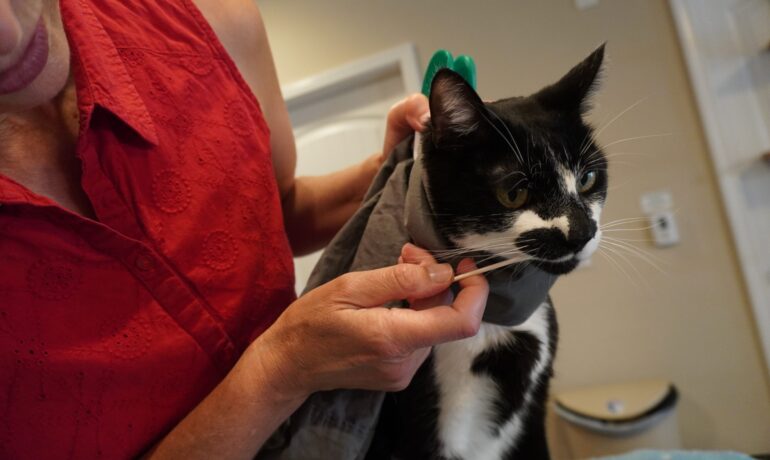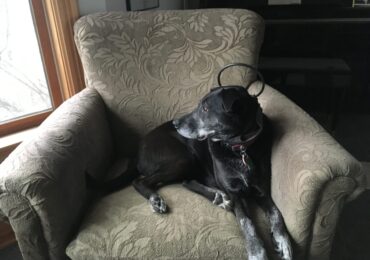Stop scruffing struggles – transition techniques to stop scruffing cats
I recently returned from the Mississippi Valley Veterinary Medical Association Conference in East Peoria Il, where I presented a full day of low-stress veterinary care topics including demonstrations and in-clinic exam videos. The afternoon was focused on specifically on the needs, clinic set up and specific handling techniques for the aggressive dog and cat. After the presentations, a seasoned veterinary technician talked to me about her struggle to stop using the scruff to restrain a cat beginning to escalate with tension. The technician acknowledged that the hold may be part of the cat’s stress escalation, but her desire to protect the veterinarian from a potential bite when made it very difficult for her to not use this technique. In short, the habit and logic of continuing to hold the cat as the cat tensed prevented her from the hands-free restraint techniques. She also admitted to feeling it was her duty to protect the doctor from any injury risk, despite the effect on the cat (which she now recognized as not good). In short, she was struggling to not scruff in the face of bite risk, despite the knowledge that scruffing is increasing bite risk in the long term.
Listening carefully to this caring and experienced technician, I asked if she tried some of the techniques on the more difficult cats. She had not because she just could not trust the techniques and her skill level to protect the doctor. I empathized with her that the towel techniques and cooperative care are the opposite of what she was taught in technician school 15 plus years ago, and scruffing gives her a sense of security. She had not considered the doctor’s responsibility for observing and responding to the cat. It is not the sole responsibility of the technician to manage the behavior of the cat. I suggested taking video on her cell phone during these exams, focusing on the hands of the doctor, handler, and cat. This would help her see the cat’s body language in response to touch and handling. Replaying the video, she can see the escalation, and when letting go as she tells the doctor, observe the de-escalation.
We discussed the need for continual communication about the patient’s response throughout the exam. If she senses the cat is tensing up, she must tell the doctor to alter the touch and approach. The doctor must listen and respond. It is the doctor’s responsibility to know the low-stress handling and care techniques as well as the handler. All too often, I see staff pushing through care focused only on restraint and not the animal’s experience. There is a struggle for time, client demands and care needs. Establish this communication, and share the responsibility of the care experience.
Busting scruffing myths
So why the big deal about scruffing? There are a lot of myths about scruffing as a natural feline behavior. These myths ignore current veterinary behavior and medical knowledge. While many practices have embraced the Fear Free, Cat-Friendly, and Low Stress Handling programs, there are still veterinary practices, shelters, colleges and cat owners who routinely scruff cats in care. The assumption that scruffing is a natural method for transporting a cat is not true. Mother cats do not move the kittens over 3 weeks of age. That scruffing is not painful is also not true. Look at the cat’s body language when scruffed – many show grimaces, and cower, especially if the cat is over 7 years old. Textbooks, webinars and video demonstrations of the same cat examined with and without scruffing (1) prove this. Numerous articles, podcasts, and on-demand webinars promote alternatives to scruffing (2). Yet despite this, there is a struggle to stop scruffing as a method of restraint. Experienced staff is the primary trainers for new hires and volunteers. If the experienced staff struggle to stop scruffing, how can we progress with low-stress feline care?
Steps to stop the struggle
I firmly believe the first step is to require all our veterinary technicians and veterinary college educators to be trained in low -stress, cooperative care handling techniques for all cats in all situations. Grabbing the scruff of a cat must be educated as a last resort, only lasting 2 seconds or less in an emergency. Some veterinary educators are at this level, but it is not uniform across all colleges. Our universities must catch up to the industry for humane handling. I see many technical and veterinary students still scruffing to remove from cages, carriers, positioning, and medicating. Low Stress, Co-Operative Care and Humane Handling have been in place for over 15 years. It is time to make this an educational standard.
Acknowledging the huge leap from force-based handling to behavior-based handling. We must be compassionate with the experienced handler who has been applauded for scruffing as a means of protecting our staff from injury. Our knowledge has advanced but it requires using these techniques to make real change. Transition techniques that provide the same anchor points, without the pain of pinching the skin or association with touch are the key to this transition. The cowl technique is an excellent scruff substitute and helps staff transition towards cat-friendly handling, especially with highly agitated cats. This technique prevents the cat from flexing the head to bite, removes the painful pinch, and associated fear of hands around the neck or body.
Follow the steps in my video and learn how to do a cowl technique quickly and effectively. Shelter volunteers, owners can learn this very quickly.

Use technology to help you see body language. Videotape your feline exams, focusing on the cat and handler’s hands. Inexpensive phone tripods or stands are simple to place on a counter or light fixture to take a quick exam video. Use an out of use smartphone that is the property of the shelter or clinic to keep all the files in one place and one owner of the images. Follow the Feline Ladder of Aggression to see how touch affects stress. Small touches mean a lot to a cat. One hand removed from the cat as the other is palpating the abdomen may decrease stress and bite risk. I know it sounds impossible – that is why you need to see it to believe it. Show coworkers the videos and celebrate the successful use of low-stress veterinary care.

The last memory is the lasting memory
Cats feel pain, cats learn, and cats remember. One or two scruffing experiences may be all it takes to create a cat that cannot be touched for care. This can happen anywhere. At home, the vaccine clinic or in a rescue. We must use the cowl technique as a fundamental skill to stop scruffing struggles. Whatever was the last experience, this is what the cat will remember best. Staff who automatically go to scruff should try the cowl technique and feel the security of holding the head just as they feel secure with scruffing. Proper technique is key. The staff will witness improvement in the cat’s behavior. New handling habits are built through practice. Have those towels and pillowcases handy and give it a try.
Learn-practice-grow
Increase your specific feline handling skills. Take the Top 5 Low Stress Handling techniques of cats if you are a veterinary, shelter, rescue staff or owner. You will learn the cowl technique along with additional hands-off handling skills. You will be safe, and leave a lasting memory of calm as you care for your cats. While RACE certified for veterinary staff, rescue staff or owners can also take this course and learn important low-stress care techniques for feline care.
Share your story
I look forward to hearing from you as you decrease your dependence on scruffing. A different technician from the same conference just sent me a wonderful email describing 3 patient exams that went a lot better using the Top 5 techniques. Hearing how people took the big step by using the cowl technique adds ideas to help others. Please email me at info@drsallyjfoote.com with your struggles, successes, and questions. We are all in this together to create a better care experience for our cats!
Thanks,
Sally J Foote DVM, CABC-IAABC
References:
1. Yin, S. Low Stress Handling, Restraint and behavior modification of dogs and cats Cattledog publishing 2009 page 318 – 319.
2. LeBeau, D. Scruffing a cat – why you should not do it and how to restrain a cat the right way. https://www.catster.com/cat-health-care/scruffing -a-cat-you-shouldnt-do-it-how-to-restrain-a-cat-safely accessed March 14, 2020
3. Foote, S. Feline ladder of aggression https://www.drsallyjfoote.com/veterinary-professional/publications-free-resources/ accessed March 14, 2020


